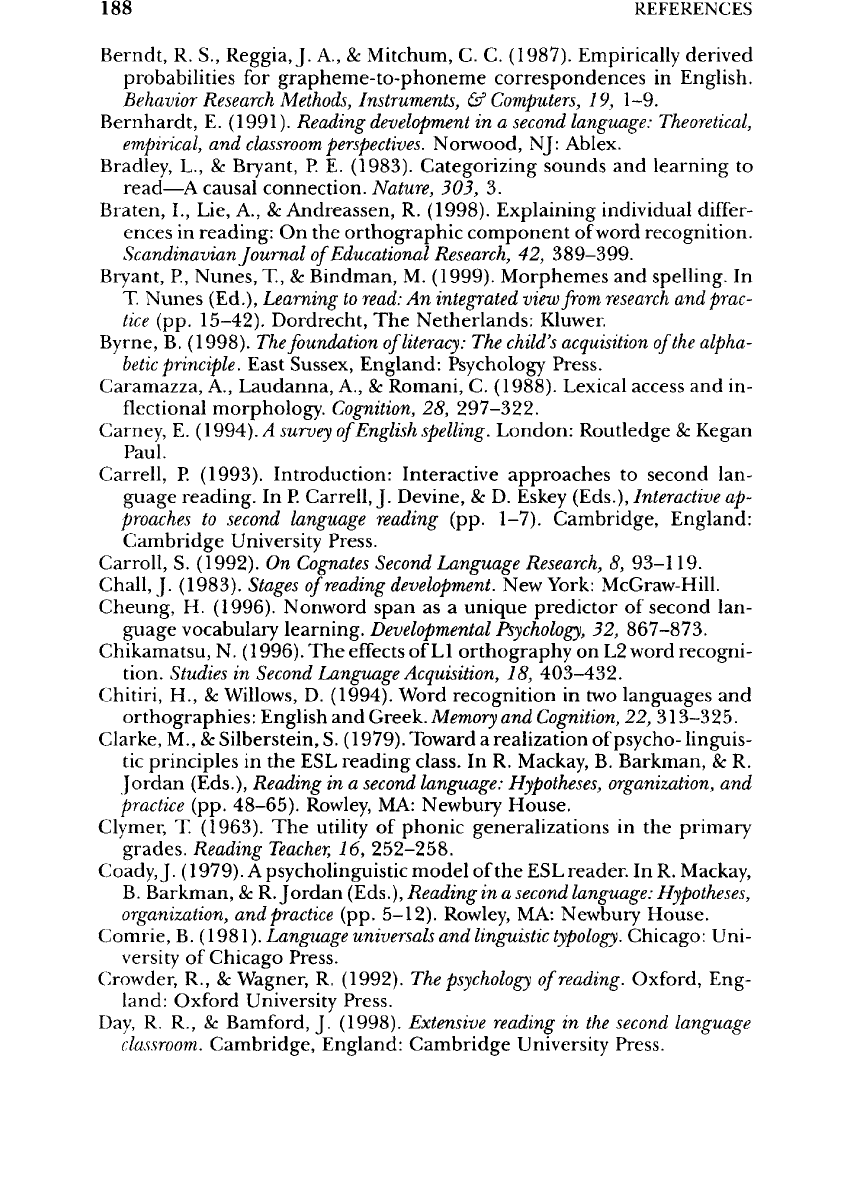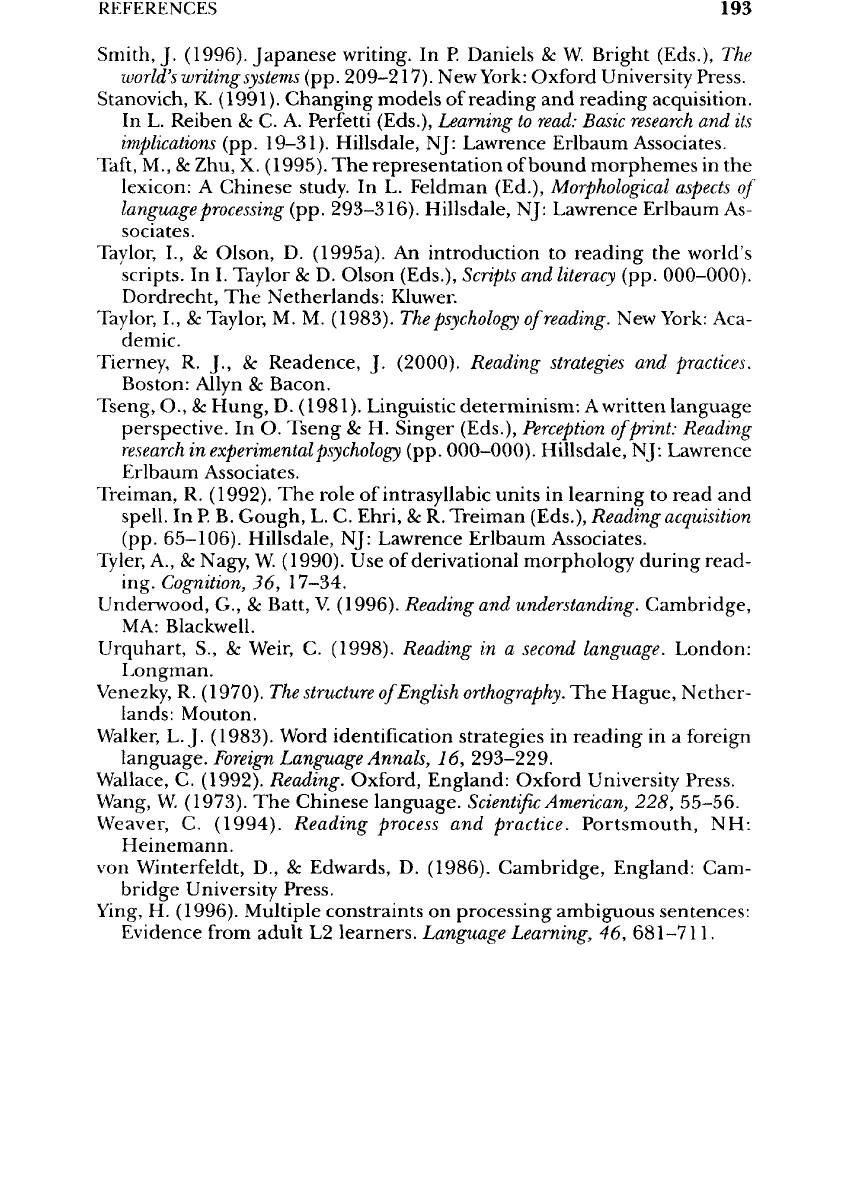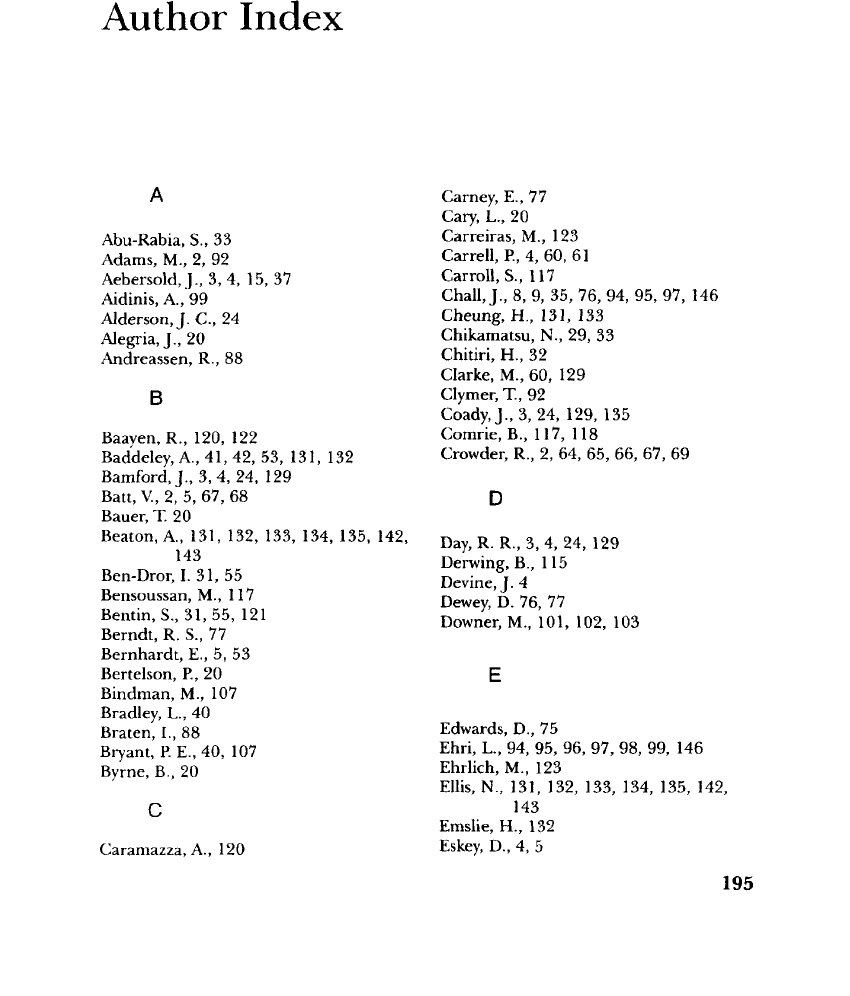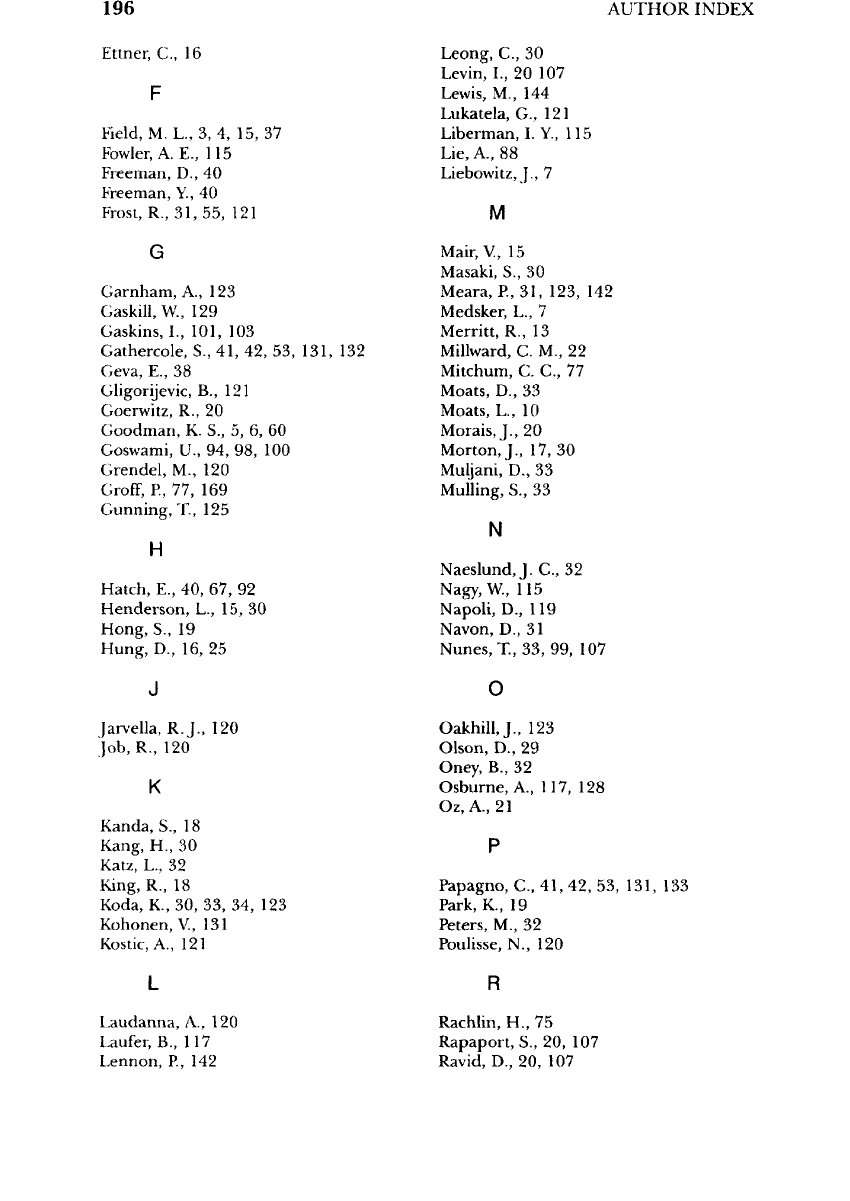Birch Barbara M. English L2 Reading: Getting to the Bottom
Подождите немного. Документ загружается.


188
REFERENCES
Berndt,
R.
S.,
Reggia,
J.
A.,
&
Mitchum,
C. C.
(1987). Empirically derived
probabilities
for
grapheme-to-phoneme
correspondences
in
English.
Behavior
Research
Methods,
Instruments,
&
Computers,
19,
1-9.
Bernhardt,
E.
(1991).
Reading
development
in a
second
language:
Theoretical,
empirical,
and
classroom
perspectives.
Norwood,
NJ:
Ablex.
Bradley,
L., &
Bryant,
P. E.
(1983).
Categorizing sounds
and
learning
to
read—A
causal connection. Nature, 303,
3.
Braten,
I.,
Lie,
A.,
&
Andreassen,
R.
(1998). Explaining individual
differ-
ences
in
reading:
On the
orthographic
component
of
word recognition.
Scandinavian
Journal
of
Educational
Research,
42,
389-399.
Bryant,
P.,
Nunes,
T., &
Bindman,
M.
(1999). Morphemes
and
spelling.
In
T.
Nunes
(Ed.),
Learning
to
read:
An
integrated
view
from
research
and
prac-
tice
(pp.
15-42).
Dordrecht,
The
Netherlands: Kluwer.
Byrne,
B.
(1998).
The
foundation
of
literacy:
The
child's
acquisition
of
the
alpha-
betic
principle.
East Sussex,
England:
Psychology Press.
Caramazza,
A.,
Laudanna,
A.,
&
Romani,
C.
(1988).
Lexical access
and in-
flectional
morphology. Cognition,
28,
297-322.
Carney,
E.
(1994).
A
survey
of
English
spelling.
London:
Routledge
&
Kegan
Paul.
Carrell,
P.
(1993). Introduction: Interactive
approaches
to
second lan-
guage
reading.
In P.
Carrell,
J.
Devine,
& D.
Eskey
(Eds.),
Interactive
ap-
proaches
to
second
language
reading
(pp. 1-7). Cambridge, England:
Cambridge
University Press.
Carroll,
S.
(1992).
On
Cognates
Second
Language Research,
8,
93-119.
Chall,
J.
(1983).
Stages
of
reading
development.
New
York: McGraw-Hill.
Cheung,
H.
(1996). Nonword
span
as a
unique
predictor
of
second lan-
guage
vocabulary
learning.
Developmental
Psychology,
32,
867-873.
Chikamatsu,
N.
(1996).
The
effects
of
LI
orthography
on L2
word recogni-
tion. Studies
in
Second
Language Acquisition,
18,
403-432.
Chitiri,
H.,
&
Willows,
D.
(1994).
Word recognition
in two
languages
and
orthographies:
English
and
Greek.
Memory
and
Cognition,
22,
313-325.
Clarke,
M.,
&
Silberstein,
S.
(1979).
Toward
a
realization
of
psycho- linguis-
tic
principles
in the ESL
reading
class.
In R.
Mackay,
B.
Barkman,
& R.
Jordan
(Eds.),
Reading
in a
second
language:
Hypotheses,
organization,
and
practice
(pp.
48-65).
Rowley,
MA:
Newbury
House.
Clymer,
T.
(1963).
The
utility
of
phonic
generalizations
in the
primary
grades. Reading
Teacher,
16,
252-258.
Coady,J.
(1979).
A
psycholinguistic
model
of
the
ESL
reader.
InR.
Mackay,
B.
Barkman,
&
R.Jordan
(Eds.),
Reading
in a
second
language:
Hypotheses,
organization,
andpractice (pp.
5-12).
Rowley,
MA:
Newbury
House.
Comrie,
B.
(1981).
Language
universals
and
linguistic
typology.
Chicago: Uni-
versity
of
Chicago Press.
Crowder,
R.,
&
Wagner,
R.
(1992).
The
psychology
of
reading.
Oxford, Eng-
land: Oxford University Press.
Day,
R.
R.,
&
Bamford,
J.
(1998). Extensive
reading
in the
second
language
classroom.
Cambridge, England: Cambridge University Press.

REFERENCES
189
Derwing,
B.,
Smith,
M.,
&Weibe,
G.,
(1995).
On
the
role
of
spelling
in
mor-
pheme recognition: Experimental studies with children
and
adults.
In
L.
Feldman
(Ed.),
Morphological
aspects
of
language
processing
(pp.
3-27).
Hillsdale,
NJ:
Lawrence Erlbaum Associates.
Dewey,
D.
(1970).
Relative
frequency
of
English
spellings.
New
York:
Teachers
College Press.
Downer,
M.
Viewer's Guide Teaching Word Identification
a
video
in the se-
ries Teaching Reading: Strategies
from
successful classrooms
(a
six-part
national training series). Produced
by the
Center
for the
Study
of
Read-
ing.
Champaign,
IL:
University
of
Illinois-Urbana.
Ehri,
L.
(1998).
Grapheme-phoneme knowledge
is
essential
for
learning
to
read words
in
English. InJ. Metsala
& L.
Ehri
(Eds.),
Word
recognition
in be-
ginning
literacy
(pp.
3-40).
Mahwah,
NJ:
Lawrence Erlbaum Associates.
Ellis,
N.,
&
Beaton,
A.
(1993).
Psycholinguistic
determinants
of
foreign lan-
guage
vocabulary
learning.
Language Learning,
43,
559-617.
Eskey,
D.
(1979).
A
model
program
for
teaching advanced
reading
to
stu-
dents
of
English
as a
foreign language.
In R.
Mackay,
B.
Barkman,
& R.
Jordan
(Eds.),
Reading
in a
second
language:
Hypotheses,
organization,
and
practice
(pp.
66-78).
Rowley,
MA:
Newbury
House.
Eskey,
D.
(1993).
Holding
in the
bottom:
An
interactive approach
to the
language problems
of
second language
readers.
In P.
Carrell,
J.
Devine,
&
D.
Eskey
(Eds.),
Interactive
approaches
to
second
language
reading
(pp.
93-100).
Cambridge, England: Cambridge University Press.
Fowler,
A. E., &
Liberman,
I. Y.
(1995).
The
role
of
phonology
and
orthog-
raphy
in
morphological awareness.
In L.
Feldman
(Ed.),
Morphological
aspects
of
language
processing
(pp.
157-188).
Hillsdale,
NJ:
Lawrence
Erlbaum Associates.
Freeman,
D.,
&
Freeman,
Y.
(1999).
The
California Reading Initiative:
a
formula
for
failure
for
bilingual students.
Language
Arts,
76(3),
241-248.
Garnham,
A.,
Oakhill,
J.,
Ehrlich,
M.,
&
Carreiras,
M.
(1995). Representa-
tions
and
processes
in the
interpretation
of
pronouns:
New
evidence
from
Spanish
and
French.
Journal
of
Memory
and
Language,
34,
41-62.
Gaskill,
W.
(1979).
The
teaching
of
intermediate
reading
in the ESL
class-
room.
In M.
Celce-Murcia
& L.
Mclntosh
(Eds.),
Teaching
English
as a
sec-
ond
or
foreign
language
(pp.
144-154).
Rowley,
MA:
Newbury House.
Gaskins,
I.
(1997).
Teaching
the
delayed
reader:
The
Benchmark School
model.
InJ.
Flood,
S. B.
Heath,
& D.
Lapp
(Eds.),
Handbook
of
research
on
teaching
literacy
through
the
communicative
and
visual
arts
(pp.
657-677).
A
project
of the
International Reading Association,
New
York:
Macmillan
Library
reference USA.
Gathercole,
S.
E.,
Willis,
C.,
Emslie,
H., &
Baddeley,
A. D.
(1991).
The in-
fluences
of
number
of
syllables
and
wordlikeness
on
children's
repeti-
tion
of
nonwords.
Applied
Psycholinguistics,
12,
349-367.
Geva,
E.
(1999). Issues
in the
development
of
second language reading:
Implications
for
instruction
and
assessment.
In T.
Nunes
(Ed.),
Learning
to
read:
An
integrated
view
from
research
and
practice
(pp.
343-367).
Dordrecht,
The
Netherlands:
Kluwer.

190
REFERENCES
Goerwitz,
R.
(1996).
The
Jewish scripts.
In P.
Daniels
& W.
Bright
(Eds.),
The
world's
writing
systems
(pp.
487-498).
New
York:
Oxford University Press.
Goodman,
K. S.
(1967).
Reading:
A
psycholinguistic
guessing
game.
Jour-
nal
of
the
Reading
Specialist,
6,
126-35.
Goodman,
K.
(1968).
The
Psycholinguistic nature
of the
reading
process.
In K.
Goodman
(Ed.),
The
Psycholinguistic
nature
of
the
reading
process.
De-
troit,
MI:
Wayne State University Press.
Goodman,
K.
(1973).
On the
psycholinguistic method
of
teaching reading.
In F.
Smith
(Ed.),
Psycholinguistics
and
Reading (pp.
158-176).
New
York:
Holt, Rinehart,
and
Winston.
Goswami,
U.
(1998).
The
role
of
analogies
in the
development
of
word rec-
ognition.
In J.
Metsala
& L.
Ehri,
(Eds.),
Word
recognition
in
beginning
lit-
eracy
(pp.
41-63).
Mahwah,
NJ:
Lawrence
Erlbaum
Associates.
Groff,
P., &
Seymour,
D.
(1987).
Word
recognition:
The why and
how. Spring-
field,
IL:
Thomas.
Gunning,
T.
(1988).
Teaching
phonics
and
other
word
attack
skills.
Springfield,
IL:
Thomas.
Hatch,
E.
(1979). Reading
a
second language.
In M.
Celce-Murcia,
& L.
Mclntosh
(Eds.),
Teaching
English
as a
second
or
foreign
language (pp.
129-134).
Rowley,
MA:
Newbury
House.
Henderson,
L.
(1982).
Orthography
and
word
recognition
in
reading.
London:
Academic.
Henderson,
L.
(1984b). Writing systems
and
reading processes.
In L.
Henderson
(Ed.),
Orthographies
and
reading:
Perspectives
from
cognitive
psy-
chology,
neuropsychology
and
linguistics
(pp. 11-24). Hillsdale,
NJ:
Law-
rence Erlbaum Associates.
Jarvella,
R.J.,Job,
R.,
Sandstrom,
G.,
&Schreuder,
R.
(1987). Morphologi-
cal
constraints
on
word recognition.
In A.
Allport,
D. G.
Mackay,
W.
Prinz,
& E.
Scheerer
(Eds.),
Language
perception
and
production:
Relation-
ships
between
listening,
speaking,
reading,
and
writing
(pp.
245-265).
Lon-
don: Academic Press.
Kanda,
Shunho.
The
Yomiuri
Weekly,
59,41,
September
24,
2000,
page
37.
Kang,
H., &
Simpson.
G.
(1996).
Development
of
semantic
and
phonologi-
cal
priming
in a
shallow orthography.
Developmental
Psychology,
32,
860-866.
King,
R.
(1996).
Korean writing.
In P.
Daniels
& W.
Bright
(Eds.),
The
world's
writing
systems
(pp.
218-227).
New
York:
Oxford University Press.
Koda,
K.
(1993).
Transferred
LI
strategies
and L2
syntactic structure
in L2
sentence comprehension.
Modern
Language
Journal,
77,
490-500.
Koda,
K.
(1995).
Cognitive consequences
of
LI
and L2
orthographies.
In I.
Taylor
& D.
Olson
(Eds.),
Scripts
and
literacy
(pp.
311-326).
Dordrecht,
The
Netherlands: Kluwer.
Lennon,
P.
(1996).
Getting "easy" verbs wrong
at the
advanced level.
IRAL,
34,
23-36.
Leong,
C.,
&Tamaoka,
K.
(1995).
Use of
phonological information
in
pro-
cessing
kanji
and
katakana
by
skilled
and
less skilled Japanese readers.
Reading
and
Writing,
7,
377-393.

REFERENCES
191
Levin,
I.,
Ravid,
D., &
Rapaport,
S.
(1999). Developing morphological
awareness.
In T.
Nunes
(Ed.),
Learning
to
read:
An
integrated
view
from
re-
search
and
practice
(pp.
77-105).
Dordrecht,
The
Netherlands: Kluwer.
Lewis,
M.
(1993).
The
lexical
approach:
The
state
ofELT
and a way
forward.
Hove,
UK:
Language Teaching Publications.
Lewis,
M.
(1997).
Implementing
the
lexical
approach:
Putting
theory
into
prac-
tice.
Hove,
UK:
Language Teaching Publications.
Lukatela,
G.,
Gligorijevic,
B.,
Kostic,
A.,
&
Turvey,
M.
(1980).
Representation
of
inflected
nouns
in the
internal lexicon.
Memory
and
Language,
8,
415-423.
Mair,
V.
(1996) Modern Chinese writing.
In P.
Daniels
& W.
Bright
(Eds.),
The
world's
writing
systems
(pp.
200-208).
New
York:
Oxford University
Press.
Meara,
P.
(1983).
Word associations
in a
foreign language. Nottingham Lin-
guistic
Circular,
11,
29-38.
Medsker,
L., &
Liebowitz,
J.
(1994).
Design
and
development
of
expert
systems
and
neural
networks.
New
York:
Macmillan.
Merritt,
R.
(1999). Technology: Introduction, Encarta
99
Encyclopedia,
CD-ROM.
Millward,
C. M.
(1996).^4
biography
of
the
English language. Fort Worth,
TX:
Harcourt Brace.
Moats,
L.
(1995).
The
missing foundation
in
teacher
education. American
Educator,
79-2,43-51.
Morais,
J.,
Gary,
L.,
Alegria,
J.,
&
Bertelson,
P.
(1979). Does awareness
of
speech
as a
sequence
of
phonemes arise spontaneously?
Cognition,
7,
323-331.
Morton,
J.,
&
Sasanuma,
S.
(1984). Lexical Access
in
Japanese.
In L.
Henderson,
Orthographies
and
reading:
Perspectives
from
cognitive
psychol-
ogy,
neuropsychology
and
linguistics
(pp.
25-42).
Hillsdale,
NJ:
Lawrence
Erlbaum Associates.
Muljani,
D.,
Koda,
K., &
Moates,
D.
(1998).
The
development
of
word rec-
ognition
in a
second language.
Applied
Psycholinguistics,
19,
99-113.
Naeslund,
J.
C.,
&
Schneider,
W.
(1996). Kindergarten letter knowledge,
phonological skills,
and
memory processes: Relative
effects
on
early lit-
eracy.
Journal
of
Experimental
Child
Psychology,
62,
30-59.
Napoli,
D.
(1996).
Linguistics:
An
introduction.
New
York: Oxford University
Press.
Navon,
D.,
&
Shimron,
J.
(1984). Reading Hebrew:
How
necessary
is the
graphemic
representation
of
vowels?
In
Henderson,
L.
Nunes,
T.
(1999).
Learning
to
read:
An
integrated
view
from
research
and
prac-
tice.
Dordrecht,
The
Netherlands: Kluwer.
Oney,
B.,
Peters,
M.,
&
Katz,
L.
(1997).
Phonological processing
in
printed
word recognition:
Effects
of age and
writing system.
Scientific
Studies
of
Reading,
1,
65-83.
Osburne,
A.,
&
Mulling,
S.
(2001).
Use of
morphological analysis
by
Spanish
LI
ESOL
learners.
International
Review
of
Applied
Linguistics,
39,153-159.
Osburne,
A.,
&
Mulling,
S.
(1998). Vocabulary recognition
in
Span-
ish-speaking
learners
of
English
as a
second language.
In A.
Osburne
&

192
REFERENCES
S.
Mulling
(Eds.),
Writing
together:
A
project
for
team
research
(pp.
12-28).
Ann
Arbor: University
of
Michigan Press.
Oz, A.
(1989). Knowing
a
Woman
(in
Hebrew). Jerusalem: Keter Publishing
House.
Papagno,
C., &
Vallar,
G.
(1992). Phonological short-term memory
and the
learning
of
novel words:
The
effects
of
phonological similarity
and
item
length.
Quarterly
Journal
of
Experimental
Psychology,
44,
47-67.
Park,
K.
(1998).
Kwangsoo's
thoughts
(in
Korean,
p.
94). Seoul, Korea:
Sodam
Publisher.
Rachlin,
H.
(1989).
Judgment,
decision,
and
choice:
A
cognitive/behavioral
syn-
thesis.
New
York:
Freeman.
Ryan,
A.,
&Meara,
P.
(1991).
The
case
of
the
invisible
vowels: Arabic speak-
ers
reading
English words. Reading
in a
Foreign
Language,
7,
531-540.
Saito,
S.
(1995).
Effects
of
pronounceability
and
articulatory
suppression
on
phonological
learning.
Perceptual
and
Motor
Skills,
81,
651-657.
Sakuma,
N.,
Sasanuma,
S.,
Tatsumi,
I.,
&
Masaki,
S.
(1998). Orthography
and
phonology
in
reading
Japanese
kanji
words.
Memory
and
Cognition,
26,
75-87.
Sasanuma,
S.
(1984).
Can
surface dyslexia occur
in
Japanese?
In
Henderson,
L.
Schmitt,
N.,
&
Meara,
P.
(1997). Researching vocabulary through
a
word
knowledge
framework.
Studies
in
Second
Language
Acquisition,
19,17-36.
Schreuder,
R., &
Baayen,
R.
(1995). Modeling morphological processing.
In L.
Feldman
(Ed.),
Morphological
aspects
of
language
processing
(pp.
131-154).
Hillsdale,
NJ:
Lawrence Erlbaum Associates.
Schreuder,
R.,
Grendel,
M.,
Poulisse,
N.,
Roelofs,
A.,
& van de
Voort,
M.
(1990).
Lexical
processing,
morphological complexity
and
reading.
In
D.
A.
Balota,
B.
Flores
d'Arcais,
& K.
Rayner
(Eds.),
Comprehension
pro-
cesses
in
reading
(pp.
125-142).
Hillsdale,
NJ:
Lawrence Erlbaum Associ-
ates.
Seidenberg,
M.
(1990).
Lexical access: Another theoretical soupstone?
In
D.
Balota,
G.
Flores
D'Arcais,
& K.
Rayner
(Eds.),
Comprehension
pro-
cesses
in
reading
(pp.
000-000).
Hillsdale,
NJ:
Lawrence Erlbaum Asso-
ciates.
Service,
E., &
Kohonen,
V.
(1995).
Is the
relation between phonological
memory
and
foreign
language
learning accounted
for by
vocabulary
ac-
quisition
?
Applied
Psycholinguistics,
16,
155-172.
Seymour,
P.
(1997). Foundations
of
orthographic development.
In C.
Perfetti,
L.
Reiben,
& M.
Fayol
(Eds.),
Learning
to
spell:
Research,
theory,
and
practice
across
languages
(pp.
319-337).
Mahwah,
NJ:
Lawrence
Erlbaum Associates.
Shimron,
J., &
Sivan,
T.
(1994). Reading proficiency
and
orthography: Evi-
dence from Hebrew
and
English. Language Learning,
44,
5-27.
Singleton,
D.
(1997). Learning
and
processing
L2
vocabulary. Language
Teaching
30,213-225.
Smith,
F.
(1971).
Understanding
reading:
A
psycholinguistic
analysis
of
reading
and
learning
to
read.
New
York:
Holt, Rinehart
&
Winston.

REFERENCES
193
Smith,
J.
(1996).
Japanese
writing.
In P.
Daniels
& W.
Bright
(Eds.),
The
world's
writing
systems
(pp.
209-217).
New
York:
Oxford University Press.
Stanovich,
K.
(1991).
Changing
models
of
reading
and
reading
acquisition.
In L.
Reiben
& C. A.
Perfetti
(Eds.),
Learning
to
read:
Basic
research
and its
implications
(pp.
19-31).
Hillsdale,
NJ:
Lawrence
Erlbaum
Associates.
Taft,
M., &
Zhu,
X.
(1995).
The
representation
of
bound
morphemes
in the
lexicon:
A
Chinese study.
In L.
Feldman
(Ed.),
Morphological
aspects
of
language
processing
(pp.
293-316).
Hillsdale,
NJ:
Lawrence Erlbaum
As-
sociates.
Taylor,
I.,
&
Olson,
D.
(1995a).
An
introduction
to
reading
the
world's
scripts.
In I.
Taylor
& D.
Olson
(Eds.),
Scripts
and
literacy
(pp.
000-000).
Dordrecht,
The
Netherlands: Kluwer.
Taylor,
I.,
&
Taylor,
M. M.
(1983).
The
psychology
of
reading.
New
York:
Aca-
demic.
Tierney,
R.
J.,
&
Readence,
J.
(2000). Reading
strategies
and
practices.
Boston:
Allyn
&
Bacon.
Tseng,
O.,
&
Hung,
D.
(1981). Linguistic determinism: Awritten language
perspective.
In O.
Tseng
& H.
Singer
(Eds.),
Perception
of
print: Reading
research
in
experimental
psychology
(pp.
000-000).
Hillsdale,
NJ:
Lawrence
Erlbaum Associates.
Treiman,
R.
(1992).
The
role
of
intrasyllabic units
in
learning
to
read
and
spell.
In P. B.
Gough,
L. C.
Ehri,
& R.
Treiman
(Eds.),
Reading
acquisition
(pp.
65-106).
Hillsdale,
NJ:
Lawrence Erlbaum Associates.
Tyler,
A.,
&
Nagy,
W.
(1990).
Use of
derivational morphology during read-
ing.
Cognition,
36,
17-34.
Underwood,
G., &
Batt,
V.
(1996). Reading
and
understanding. Cambridge,
MA:
Blackwell.
Urquhart,
S., &
Weir,
C.
(1998). Reading
in a
second
language. London:
Longman.
Venezky,
R.
(1970).
The
structure
of
English
orthography.
The
Hague,
Nether-
lands: Mouton.
Walker,
L. J.
(1983). Word identification strategies
in
reading
in a
foreign
language.
Foreign
Language Annals,
16,
293-229.
Wallace,
C.
(1992). Reading. Oxford,
England:
Oxford University Press.
Wang,
W.
(1973).
The
Chinese
language.
Scientific
American, 228,
55-56.
Weaver,
C.
(1994). Reading process
and
practice. Portsmouth,
NH:
Heinemann.
von
Winterfeldt,
D.,
&
Edwards,
D.
(1986). Cambridge, England: Cam-
bridge University Press.
Ying,
H.
(1996).
Multiple constraints
on
processing ambiguous sentences:
Evidence
from adult
L2
learners.
Language Learning,
46,
681-711.

This page intentionally left blank

Author Index
Abu-Rabia,
S., 33
Adams,
M.,
2, 92
AebersoldJ.,
3, 4,
15,37
Aidinis,
A.,
99
AldersonJ.
C-,
24
Alegria.J.,
20
Andreassen,
R.,
88
B
Baayen,
R.,
120,
122
Baddeley,
A.,
41,
42, 53,
131,
132
Bamford.J.,
3, 4, 24, 129
Batt,
V, 2, 5, 67, 68
Bauer,
T. 20
Beaton,
A.,
131, 132, 133,
134,
135, 142,
143
Ben-Dror,
I. 31, 55
Bensoussan,
M.,
117
Bentin,
S.,
31,55,
121
Berndt,
R.
S.,
77
Bernhardt,
E., 5, 53
Bertelson,
P., 20
Bindman,
M.,
107
Bradley,
L., 40
Braten,
I.,
88
Bryant,
P.
E.,
40,
107
Byrne,
B.,
20
Caramazza,
A.,
120
Carney,
E.,
77
Gary,
L.,
20
Carreiras,
M.,
123
Carrell,
P., 4, 60,
61
Carroll,
S.,
117
Chall,
J.,
8, 9, 35, 76, 94, 95, 97, 146
Cheung,
H.,
131,
133
Chikamatsu,
N., 29, 33
Chitiri,
H.,
32
Clarke,
M.,
60, 129
Clymer,
T.,
92
Coady,J.,
3, 24,
129,
135
Comrie,
B.,
117,
118
Crowder,
R.,
2, 64, 65, 66, 67, 69
Day,
R.
R.,
3, 4, 24, 129
Derwing,
B.,
115
Devine,
J. 4
Dewey,
D. 76, 77
Downer,
M.,
101, 102,
103
Edwards,
D.,
75
Ehri,
L.,
94, 95, 96, 97, 98, 99, 146
Ehrlich,
M.,
123
Ellis,
N.,
131,
132,
133,
134,
135, 142,
143
Emslie,
H.,
132
Eskey,
D.,
4, 5
195

196
AUTHOR
INDEX
Ettner,
C.,
16
Field,
M. L.,
3,4,
15, 37
Fowler,
A. E.,
115
Freeman,
D., 40
Freeman,
Y., 40
Frost,
R.,
31,55,
121
G
Garnham,
A.,
123
Gaskill,
W., 129
Gaskins,
I.,
101,
103
Gathercole,
S.,
41, 42, 53,
131,
132
Geva,
E.,
38
Gligorijevic,
B., 121
Goerwitz,
R.,
20
Goodman,
K.
S.,
5, 6, 60
Goswami,
U., 94, 98, 100
Grendel,
M.,
120
Groff,
P., 77, 169
Gunning,
T.,
125
H
Hatch,
E.,
40, 67, 92
Henderson,
L.,
15,30
Hong,
S.,
19
Hung,
D.,
16, 25
Jarvella,
R.J.,
120
job,
R.,
120
K
Kanda,
S.,
18
Rang,
H.,
30
Katz,
L.,
32
King,
R.,
18
Koda,
K.,
30, 33, 34, 123
Kohonen,
V, 131
Kostic,
A.,
121
Laudanna,
A.,
120
Laufer,
B.,
117
Lennon,
P.,
142
Leong,
C.,
30
Levin,
I.,
20 107
Lewis,
M.,
144
Lukatela,
G.,
121
Liberman,
I.
Y.,
115
Lie,
A.,
88
Liebowitz,
J., 7
M
Mair,
V,
15
Masaki,
S.,
30
Meara,
P., 31,
123,
142
Medsker,
L.,
7
Merritt,
R.,
13
Millward,
C.
M.,
22
Mitchum,
C.
C.,
77
Moats,
D.,
33
Moats,
L.,
10
Morais,J.,
20
Morton,
J.,
17, 30
Muljani,
D.,
33
Mulling,
S.,
33
N
Naeslund,J.
C.,
32
Nagy,
W,
115
Napoli,
D.,
119
Navon,
D.,
31
Nunes,
T.,
33,99,
107
o
Oakhill,J.,
123
Olson,
D.,
29
Oney,
B.,
32
Osburne,
A.,
117,
128
Oz,A.,
21
Papagno,
C.,
41, 42, 53,
131,
133
Park,
K.,
19
Peters,
M.,
32
Poulisse,
N.,
120
R
Rachlin,
H.,
75
Rapaport,
S.,
20, 107
Ravid,
D.,
20, 107

AUTHOR
INDEX
197
Readence,J.,
92, 93
Reggia,J.A.,
77
Roelofs,
A.,
120
Romani,
C.,
120
Ryan,
A.,
31
Saito,
S.,
134
Sakuma,
N., 30
Sasanuma,
S.,
17, 30
Sandstrom,
G.,
120
Schmitt,
N.,
123,
142
Schneider,
W, 32
Schreuder,
R.,
120,
122
Seidenberg,
M., 81
Service,
E., 131
Seymour,
D., 77, 169
Seymour,
P., 97
Shaw,
G. B., 75
Shimron,
J. 31
Silberstein,
S.,
60, 129
Sivan,
T,
31
Simpson,
G. 30,
Singleton,
D.,
120
Smith,
R, 6
Smith,
J. 17
Smith,
M.,
115
Stanovich,
K., 65
T
Turvey,
M. 121
Tyler,
A.,
115
u
Underwood,
G.,
2, 5, 67, 68
Urquhart,
A.H.,
24
Urquhart,
S.,
3
V
vande
Voort,
M.,
120
Venezky,
R.,
62, 63, 151
Villar,
G.,
133
Voitus,
A.,
99
von
Winterfeldt,
D.,
75
W
Wagner,
R.,
2, 64, 65, 66, 67, 69
Walker,
L.J.
117
Wallace,
C.,
4, 5, 24, 40, 55
Wang,
W, 38
Weaver,
C.,
64, 65, 69, 92, 93
Weibe,
G.
115
Weitzman,
R.,
18
Weir,
C.,
3
Willis,
C.,
132
Willows,
D.,
32
Taft,
M.,
122
Tamaoka,
K. 30,
Tatsumi,
I.,
30
Taylor,
I.,
22, 29
Taylor,
M.,
22
Tierney,
R.J.,
92, 93
Treiman,
R.,
97
Tseng,
O.,
16, 25
Ying,
H., 142
z
Zeldis,J.,
21
Zhu,
X.,
122
